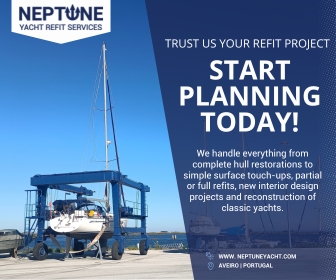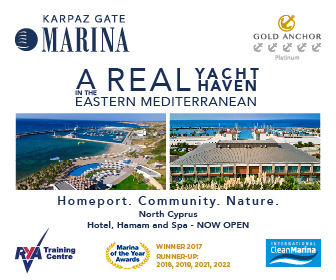France, Netherlands, Germany: Useful Information on The Inland Waterways of Europe
Although Noonsite is mainly concerned with coastal ports, we believe a summary of information about the network of inland waterways in Europe is a useful addition to our cruising information. Many cruisers choose to travel from coast to coast via the canal network or take some time out on the calmer waters on the inland waterways. This report provides a brief overview.
Published 1 year ago, updated 11 months ago
This report has been checked and updated as of March 31, 2024.
Introduction to the canals and rivers of Europe
The network of canals and rivers in Europe is extensive and provides a whole new way of exploring the continent. The rivers, in particular, are often heavily used commercial waterways and so it is necessary to be aware and to abide by, the navigation rules applicable. These vary from country to country and are also often applicable to a particular river.
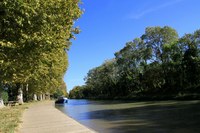

On several of the major rivers, it is possible for masted boats to navigate up them for a considerable distance, usually to a prominent city (e.g. Amsterdam, Rouen, Bordeaux). However, facilities exist at many of the ports sited at the entrance to the network to have the mast removed and either stowed on the boat, stored ashore or transported to your final destination.
Most of the rivers are deep and so for most sailing boats, draft is not a problem.
The canals are likely to present more of a problem, so careful consideration must be given to your route if your fixed draft is more than 1.8 metres and your air draft is, (or cannot be made less than), 3.5m. On some routes, the air draft can be as low as 2.4m, although this varies with the water level. Also, it is necessary to remember a boat will float about 10cm lower in freshwater and that heavy rainfall, even some miles away, can raise the water level and, therefore, reduce the clearance under bridges.
Boats under 20m are classed as ‘small craft’ and are exempt from having AIS when otherwise this is a requirement (i.e. on the River Rhine). It also means that such craft must give way to any commercial vessels as per the CEVNI rules.
One other thing to be aware off, is whether you are travelling ‘upstream’ or ‘downstream’ as this can affect rights of way. It is important to be familiar with the CEVNI rules and the signage used on the system.
Most of the requirements for France also apply to the rest of the European inland waterways network. On some of the major rivers, there are extra regulations so it is important to be familiar with them. Most frequently this involves monitoring certain VHF channels on the major rivers.
See this website for a copy of the CEVNI rules applicable throughout the European Inland waters: CEVNI – European Code for Inland Waterways
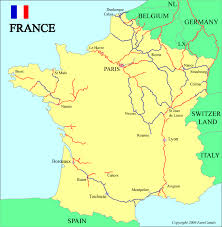

Travelling through the French canal system
Many cruisers use the French canal system as a leisurely alternative to reach the Mediterranean from Northern Europe (or vice versa). However, it does have restrictions, the principal one being the necessity to remove the mast. There are two options here. One is to lash the mast to the boat itself which can restrict movements about the boat. The second option is to have the mast transported to your destination port for you, which, obviously involves extra costs.
It’s important to note that the depths on the charts and guides is a best-case scenario and you should err on the side of the caution as depths can often be quite a bit lower, especially after low-rainfall and during the summer period. See https://www.french-waterways.com/practicalities/canal-depths/ for more details.
Other considerations regarding the French canal system
Although, in theory, the route can be travelled at any time of the year, each season has things to consider. It is important to remember that much of the canal maintenance takes place out of season and so it is crucial to check the website Voies Navigables de France (Waterways in France) for maintenance projects and lock closures. The site is updated weekly.
Summer:
- The weather can be really hot.
- Water levels can be lower if the weather is dry.
- Encounters with inexperienced recreational rental boaters.
- More crowded moorings.
Autumn:
- Raised water levels in rainy weather and stronger currents in the rivers.
- Leaves in the water blocking the engine cooling system.
- Canal-side facilities closing down.
Winter:
- Shorter days means a longer overall journey time.
- Facilities closed.
- Need for self-sufficient heating system.
Spring:
- Good water levels in the canals although some rivers might be in flood.
- Weather is often good – warm and not too hot.
- Facilities opening up (especially further south).
Speed Limits:
The speed limit on the canals is 6km/hr (3.2 knots).
On the rivers, it varies from 15km/hr (8 knots) to 30km/hr (16 knots).
Locks:
There are large commercial locks (most are on the rivers) and these are manned, but the available moorings can be difficult for small recreational craft.
The small locks are almost all automated with various methods of operating them. There is always a method of contacting someone for help if you encounter a problem.
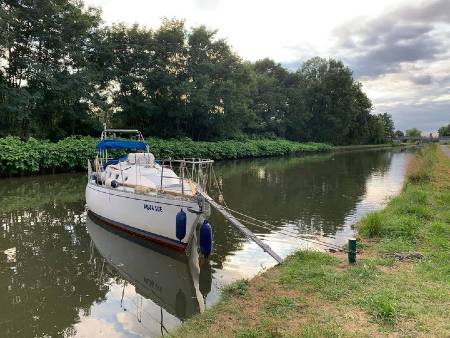
Documentation required for the French waterways:
- A Certificate of Competence (i.e. ICC or equivalent)
- A CEVNI endorsement or evidence of having passed the CEVNI test.
- A copy of CEVNI rules on board.
- An official ownership document.
- Boat’s insurance policy including third party damages insurance.
- Proof of VAT payment.
- VHF Radio operator’s certificate.
- Vignette Plaisance (permit/license/tax sticker for French waterways). This can be bought online and at several locations.
- Passports for each crew member.
Mandatory equipment for the French waterways:
- VHF radio modified to transmit an ATIS number (MMSI no. preceded by 9).
- Lifejackets for each crew member.
- At least 2 long mooring lines.
- Fenders with 2 lines attached.
- Life buoy and rope.
- Fire blanket.
- Fire extinguisher.
- Anchor.
- Horn.
Other requirements:
- The boat’s name or number clearly visible.
- The helmsman to be over 16 years.
- The helmsman to be able to have a clear line of sight around the boat and to be able to hear information from the crew.
See this useful website for more detailed information about equipment requirements: French Waterways/Boat Equipment
Other useful equipment for inland waterways:
- Have a selection of gas bottle connectors or use an electric stove (mains power is often free at moorings).
- Use a WiFi booster antenna if wishing to make use of free WiFi networks.
- Have several spare fuel cans and stock up whenever possible. You will be doing a lot of motoring.
- Having bikes on board makes provisioning easier.
- Take extra fenders or tyres (which are often discarded by yachts coming the other way) for extra fendering.
Useful links for the French Waterways:
- For full details of Clearing into France, see the Noonsite/France/Formalities page.
- A very useful site on the French canals in detail with free downloads.
Waterways of France by Region - Waterways of France
- Information on the various routes to the Mediterranean:-
Michael Briant – French Canals - Details of maintenance and lock closures:-
www.vnf.fr - A useful website clearly explaining the rules and advice for travelling on the canals:-
French Waterways/Practicalities - Website of the European Boating Association:-
European Boating Association/Inland Waterways - Information about the 156km long Canal de la Somme:-
Canal de la Somme - An interesting article on the attractive Canal de Bourgogne:-
Cruising Guide to canal de Bourgogne - A report on a late summer transit with limited depth:-
France: Navigating the Canals and Rivers in a Small Yacht
Regulations for Netherlands Waterways
- For full details of Clearing into the Netherlands, see the Noonsite/Netherlands/Formalities page.
- Sail Together on the Dutch Waterways. This website gives useful advice for when sailing/motoring on the Dutch waterways. The regulations are very similar to those outlined previously for the French canals.
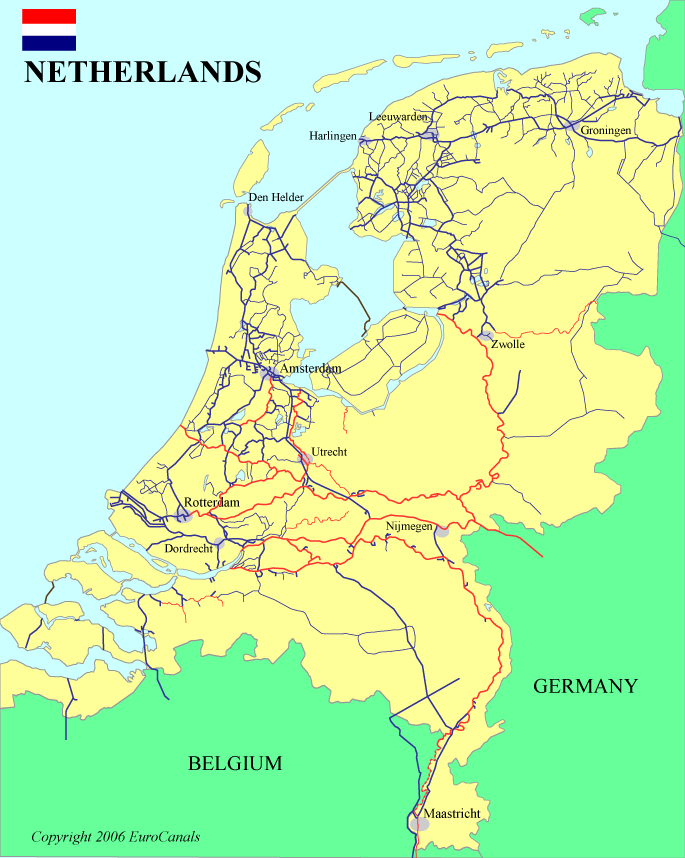

Useful Links for Netherlands Waterways
Regulations for German Inland Waters
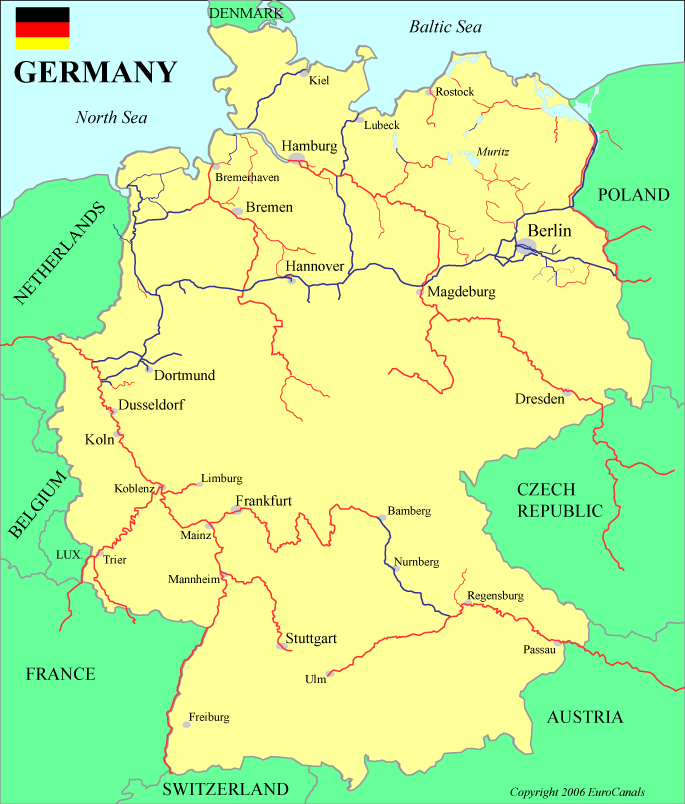
- For full details of Clearing into Germany, see the Noonsite/Germany/Formalities page.
- The maximum length of boats on the German canals is 15m.
- European Waterways/Germany. A useful website with detailed information on the German waterways, rivers and canals. It include information on the various marinas.
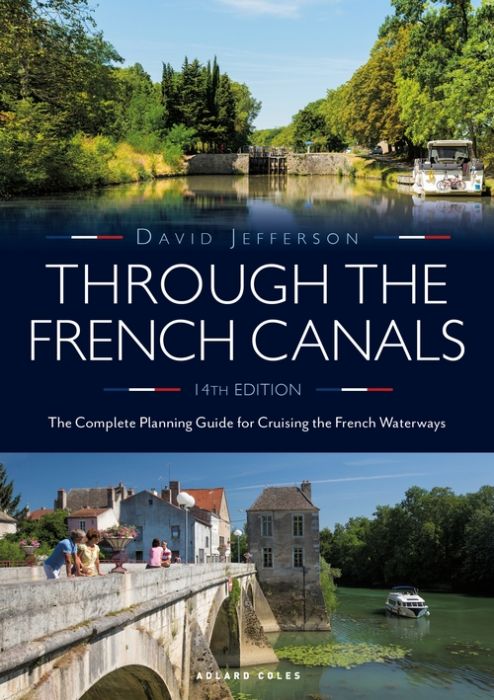
Useful Publications for Cruising European Canals and Waterways
- CA Free Guidance Notes for the European Inland Waterways
- RYA European Waterways Regulations
- Through France via the Inland Waterways: Published by the Cruising Association.
- Through the French Canals: Published by Adlard Coles
- Inland Waterways of France 1, 2 and 3: Published by Imray
- Cruising the Inland Waterways of France and Belgium: Published by the CA.
- Inland Waterways of Germany: Published by Imray.
- The German Rhine: Published by the CA.
- Inland Waterways of the Netherlands: Published by Imray.
- 50 Great inland Cruising Routes in the Netherlands: Published by the CA.
- Through the Netherlands via the Standing Mast Routes: Published by the CA.
- France, Germany, Netherlands: Cruising the River Moselle/Mosel: Published by the CA.
Cruiser’s Reports on European Waterways
- Canal cruising in France: how to prepare the boat & crew (July 2022)
- France: Navigating the Canals and Rivers in a Small Yacht (September 2021)
- The Voyage of yacht Sharlyn: From the end of the Danube to the end of the Volga (November 2018)
- Netherlands To Turkey Via European Canals & Rivers (September 2015)
Cruiser’s Blogs/Vlogs on European Waterways
- Tilda – Which route to choose sailing European Inland Waterways (2021)
- Magic Carpet – Europe’s Inland Waterways in Winter (2020)
- Distant Shores – Top 10 Canal Journeys (2013)
Other Links:
- Yachting Monthly: Sailing the French Canals – Lessons Learnt (2021)
- BoatNews.com: Three canals in Northern Europe where you don’t have to remove your mast (2020)
- SAIL: The European Great Loop (2018)
Related to following destinations: France, Germany, Netherlands
Related to the following Cruising Resources: Cruising Information, Documents, European Union, General, Mediterranean, Routing, World Regions Information






